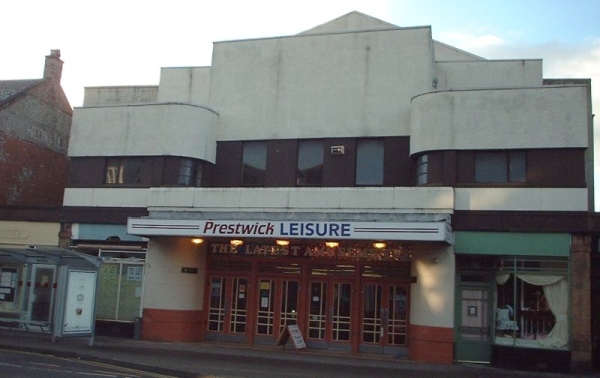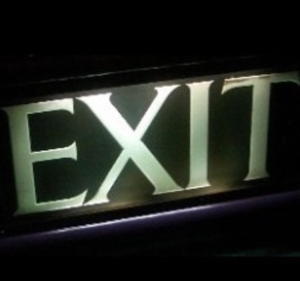Background
|
The C(s)-listed
Broadway Cinema at 80
Main Street, Prestwick opened in
April 1935, having been built for the Prestwick Cinema Company Limited.
The
Chairman of the company was J.C. Sword, who ran a haulage business in
Airdrie, Lanarkshire.
Papers from the 1940s
also list Sir Alexander B. King as Managing Director, as well
as James McClure and T.W. Richardson. The latter seems to have been
replaced by
J.C. McGregor by the early 50s, whilst the secretary during the same
period was
one William Gardner.
Of these names, Alex King
seems to have been the most hands-on
of the directors, and much correspondence survives between the famous
Scottish
cinema mogul and his long-time manager at the Broadway, James C. Ross,
to which
we shall return later.
|
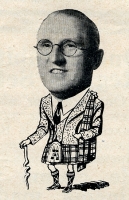
Sir A.B. King
|
Architect
The architect for the Broadway was Alister G. MacDonald, a
figure just as interesting as the cinema’s colourful Managing
Director.
MacDonald was the eldest son of Britain’s first-ever Labour
Prime Minister,
Ramsey MacDonald. Alister’s first cinema job was probably as
Clerk of Works to
Frank Verity for Paramount’s Plaza
in London’s Regent Street in 1925-6. After a
spell studying skyscrapers and sound insulation design in America, he
went on
to become the leading architect of newsreel cinemas in Britain. The
skills he
learned in the USA were to prove useful when it came to designing these
small,
compact news cinemas in cramped, awkward sites, such as railway
stations. His
most famous such designs were at Victoria and Waterloo Stations in
London, although sadly his plans for a
cinema in Glasgow's Central Station were unrealised. He
also built numerous conventional cinemas, most notably for the
Caledonian Associated
Cinemas group (CAC) in Scotland, including the Playhouses in Peebles, Montrose [now
demolished]
and Elgin (all
1932), as well as the Empire Cinema for the Empire Exhibition in
Glasgow’s Bellahouston Park in 1938 – which was
later moved to Lochgilphead,
where it survives as a guesthouse.
Exterior Design
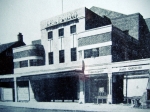
1930s exterior
(courtesy Bruce Peter)
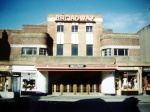
1960s exterior
(courtesy Bruce Peter) |
MacDonald’s
design for the Broadway had a symmetrical,
streamlined façade, with a recessed, three-storey centre
section, flanked by
two-storey wings curving in to meet it on both sides. These in turn
were flanked
by single-storey shop units extending out to each side. A car park was provided at the rear.
The shop units had attractive deco glazing,
and were separated
from each other by a vertical band of horizontally-striped
coloured
stone. These curved in
to a main entrance portico set back from the
street, with a terrazzo floor and four sets
of double doors,
again with attractive deco glazing in both the doors,
and the
panels above. A small canopy projected slightly out into the street
above the
entrance.
The central section of the façade is largely made from
reconstituted
stone, and
has a vertical emphasis. The four tall bands of stone are relieved by
three
similarly narrow window bays. These had taller windows at first floor
level to
illuminate the café, and smaller windows directly above,
separated by a
lighter
coloured stone infill. At the top of the central section of the
façade
was a
large horizontal Broadway name sign, set on a horizontal string course,
coloured red and outlined in neon.
By contrast, the flanking wings of the café were made
largely
of brick, and had a horizontal emphasis, with stone string courses
above the
windows and at coping level. The windows were wide and narrow, and
followed the
curve of the wall at ground floor level below. |
|
Main Foyer
Once inside, the Broadway
had a surprisingly deep
foyer
area, which was split level, with the wider rear section being down a
few
steps. The narrower outer section contained a central island paybox at
the top of
the steps, whilst the wider rear level had a multitude of doors leading
to the gents toilets
to the right, the stalls straight ahead, and
the ladies and car park
to the left. The main staircase to the balcony
was on the right, while a secondary stair to the balcony foyer
and adjacent offices was located in the corridor to the car park.
Another feature of the
foyer was the double height section
which formed a small, rectangular
lightwell from the balcony foyer above.
MacDonald cleverly put large windows in the rear wall of the
café so that light
from the main façade windows would illuminate both the
balcony foyer behind it,
and the rear stalls foyer below.
|

 |
Balcony Foyer

|
The balcony
foyer was compact, and featured a sloping
ceiling
which followed the rake of the rear balcony above. As elsewhere in the
cinema,
the lower half of the walls was adorned with dark wood panelling and
metal
banisters, whilst the upper walls were relieved by linear horizontal
notches.
The ceiling above the lightwell was deeply
coffered, and some nice metal balustrades
prevented one from leaning too far into the void below! |
|
Café
As well as various
offices and toilets, the front
of the
building at first-floor level featured the café, which again
featured a
coffered ceiling and rich wooden panelling on the lower half of the
walls.
A faux
fireplace
adorned the rear wall between the two internal windows, and
in one of
the corner niches in the flanking wings, the counter and
café equipment
were discretely
situated out of the way.
A dumb
waiter led to a kitchen area to the
side of the foyer below, and a small staircase
that would have given
direct access to the cafe was also present.
Again,
MacDonald’s attention to finishing is evident
here, with highly polished wooden doors, featuring glazed inlays,
stainless
steel or chrome banisters
and dados,
lovely little art deco
light fittings
and
moulded triangular architraves above the doors. Almost all doors had
illuminated
glass signs
above them, and featured chrome hexagonal
handles.
|


|
Auditorium
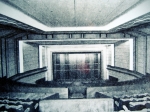
1930s interior
(courtesy Bruce Peter)
|
The
auditorium itself was relatively simple but effective. Above the
curved wooden panelling,
the sidewalls were relieved only by shallow,
vertical
overlaps which ran right
up onto the ceiling. MacDonald had been known to use such features at
other
cinemas such as the Montrose Playhouse, as they were a relatively cheap
way of
producing a three-dimensional effect with light and shade.
In the
centre of the ceiling, a large rectangular
trough feature, with
scalloped internal edges and recessed lighting, ran almost right up
to the deep ante-proscenium
arch. This arch was very wide, and splayed
into an
inner ante-proscenium much closer to the actual screen opening. The
curve of the balcony front continued right up to the proscenium.
Rather
curiously, the auditorium also features ceiling ventilation grilles
decorated
with a camel motif! At the rear of the balcony, an exit led to the
secondary staircase, and access to the
projection
room and store
rooms. A vomitory
from the upper foyer came out in the centre of the balcony.
The rear stalls had horizontal banding running along the back wall, and
a central deeply stepped rectangular recess in the ceiling under the
balcony. |
Closure &
Conversion
|
The cinema soldiered on
until the 1960s, and
contemporary documentation lists it as being on part-time
bingo by March 1964, which took over completely around 1966. It
was to remain on bingo for some time, although a later brief attempt to
revive part-time film shows seems not to have been a success.
The history of the
building
after this is not clear, but by the late 1990s, it had been converted
again.
The ground floor entrance foyer was clad with false wall and
ceiling panelling,
and converted to an amusement arcade. The main stair to the balcony was
blocked
off, but interestingly, all the other original doors were retained, and
the
island paybox was also pressed back into use as a change booth.
In the rear stalls, a small area was walled off to become a
pool room, retaining some of the original plasterwork from that area,
although
painted in a uniform dark
colour. Perhaps most destructively of all, however,
the front of the main auditorium area had four squash courts built
into it, extending into
and damaging both the stage and proscenium at the front, and the front
of the
balcony at the rear. The balcony itself, and the upper foyer and
café areas,
fell out of public use at this time, and it was renamed the Prestwick
Leisure Centre.
|
|
Future Plans
 |
The building was sold in
2003 to the Buzzworks Group,
who run pubs and restaurants throughout Ayrshire. That same year,
planning
permission was given to demolish the auditorium block of the cinema,
replacing
it with a hotel development. The main foyer block would be retained as
part of
this redevelopment, and would house a restaurant, coffee shop and
cocktail lounge.
Surviving art deco features are to be retained where appropriate.
At the time of writing
(Feb 2006), no work appears to have
started, and the building has been closed to the public for some time.
|
Recent Survey
This allowed for an opportunity to tour the
cinema in
December 2005, which is when the interior pictures presented here date
from.
This turned out to be a remarkably fortuitous visit. When Historic
Scotland
awarded the building their lowest statutory protection in the form of a
Grade C(s)-listing
in 2004, they had not been able to view the interior, and as the
pictures show,
the upper levels are notable for both the wealth and condition of
original
features.
Sadly, the exterior
has been
simplified over the years, with some of
the upper windows blocked off, and much of the façade
rendered and painted in a
fairly plain fashion,
although the main doors
survive, and at least one shop
unit retains its original glazing. Inside, however, although the ground
floor
foyer has been altered for the aforementioned amusement arcade, the
balcony
foyer could almost be as it was when it opened in 1935. An art-deco
style
carpet,
with what at first appears to be a monochrome fan pattern reveals
itself to have faded flourishes of pinks
and yellows on closer inspection.
Above the doors, the glass
signage still survives, and the café is more or
less
all intact, including light
fittings - even the balcony foyer appears to have
original rattan sofas
under piles of accumulated junk, although the light well
has been filled in at some point. All through these long-disused areas,
wonderful wooden panelling
adorns the lower half of the walls, and even
stepping into the toilets reveals period sanitary ware and possibly
even
original linoleum!
In the balcony itself,
more of
the carpeting survives, although
all the seating has been removed,
and apart from the wooden frames of the
squash courts below, the walls, ceiling and much of the proscenium arch
survive
intact. In the projection room, a wide variety of equipment, spares and
various
other trinkets essential for running a cinema in the heyday of the
medium lie where
they were left nearly 40 years ago, whilst the original Broadway name sign
is piled up in
one corner of the booth, in the shadow of the Gaumont-Kalee GK20 projectors
with President arc lamps and Westrex sound equipment.

Archive
Documentation
Perhaps most remarkably of all, an enormous
archive of written
and printed material survives which gives a fantastic insight into the
minutiae of running a cinema from roughly the late 40s to the late 60s.
Much of
this archive material consists of correspondence from the MD Sir Alex
B. King to
the manager for all of that time, James C. Ross. Letters found detail
everything
from break-ins
to Sunday opening
discussions, patrons tearing
their clothes on seats, curtain
cleaning to the difficulties of obtaining replacement fixtures, and
even ice-cream supply
problems due to post-war shortages! Projectionists
detail damage to prints
in their logbook, whilst arrangements
to share a
visiting Hollywood starlet Vivian Blaine
with King’s Seamore
cinema in Maryhill are detailed in
terms of the financial gain
for the cinema.
In 1959, A.B. King instructs his manager that under no
circumstances should an advert entitled “A Happy
Family Is A Planned Family” be
shown in his hall, whilst two years later, he is detailing a strategy
to help
quash rumours
of the cinema’s closure. Sadly, a document dated March 1964 shows
the cinema to be running bingo several times a week, whilst an undated
blank
application form invites patrons to join the Broadway Bingo and Social Club,
still under the auspices of the erstwhile J.C. Ross, who is by then
listed as
secretary.
Conclusion
All in all, the Prestwick Broadway is a
remarkable survival.
The furnishings and fittings which survive today may not be 100%
original, but
the fascinating and invaluable archive documents show that where
maintenance
and replacement was necessary, much effort was made to obtain matching
and
appropriate repairs or replacements. To this end, it is one of the most
atmospheric
surviving 1930s cinemas in Scotland, and still very much evocative of
the
period in which it was first built. With the demolition of Alister
MacDonald’s
famous newsreel cinemas in Waterloo and Victoria Stations in London, it
is also
perhaps his best surviving cinema commission, made all the more
interesting for
the large written archive, which gives a glimpse into the day-today
running of
a cinema from its heyday to its slow demise at the hands of bingo.

Click here
for a
picture of the rear of the auditorium, or here
for a surviving sign in the
car park.
Many thanks to the
staff of the
Buzzworks Group for granting
access to the building in order to record it.
 |
An exhaustive
gallery of interior photos from the recent survey can be found here. |
 |
More extracts
from the surviving archive documentation can be seen here. |
Prestwick Picture House
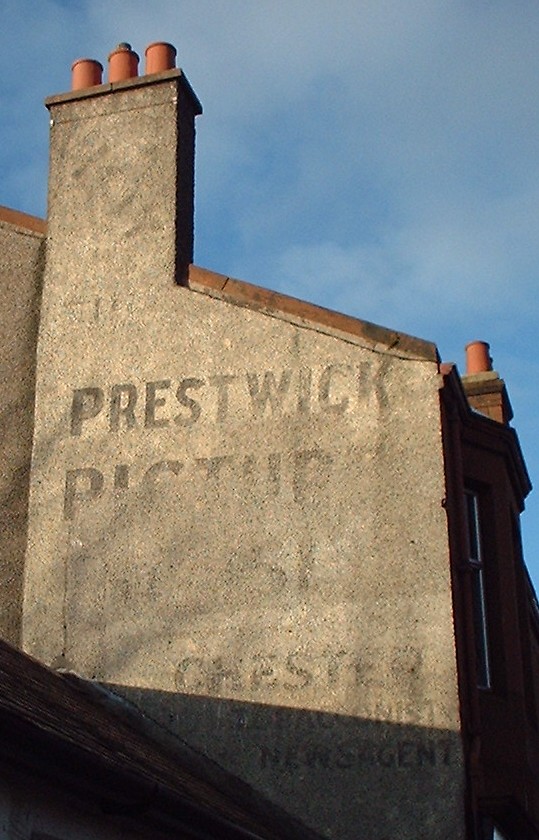
"Visit the Prestwick Picture House" Although nothing remains of the building
itself, an advert
survives on the end of a building in Prestwick Main Street.
The Picture House opened in the 1920s, and burnt down in 1976.
|


